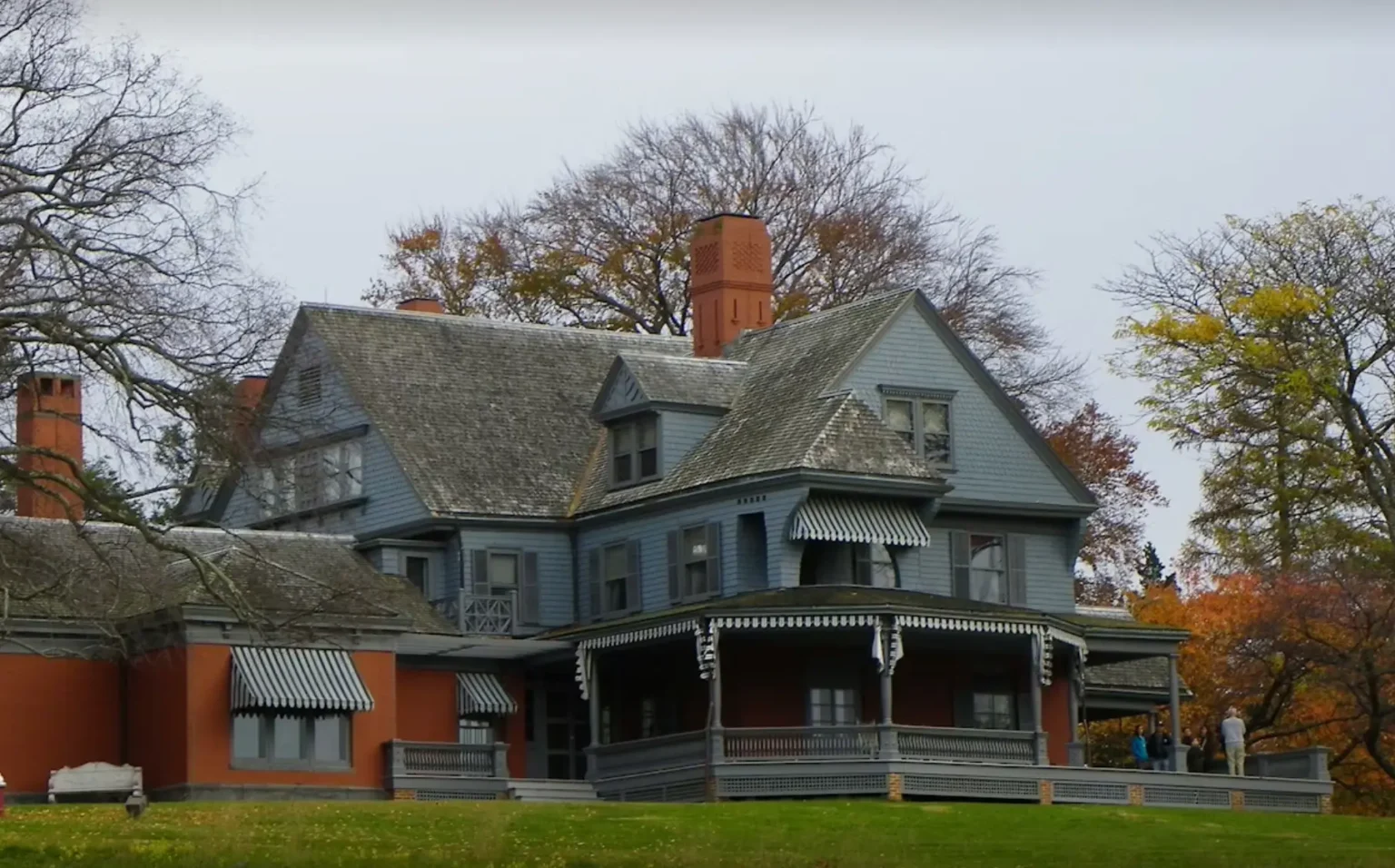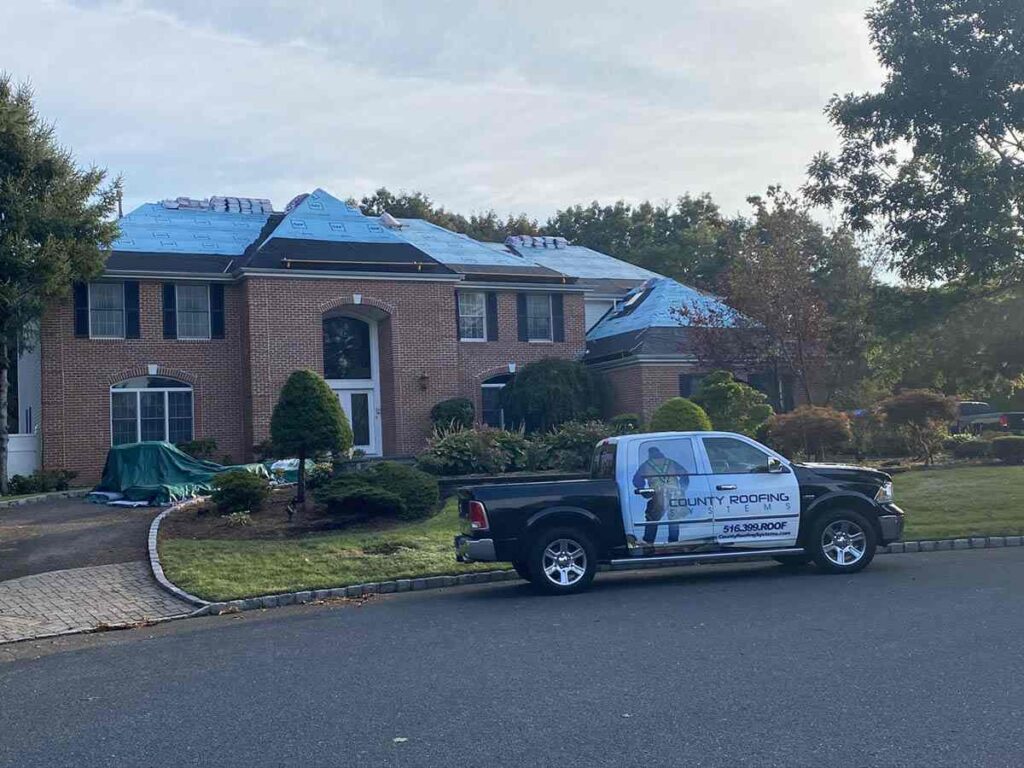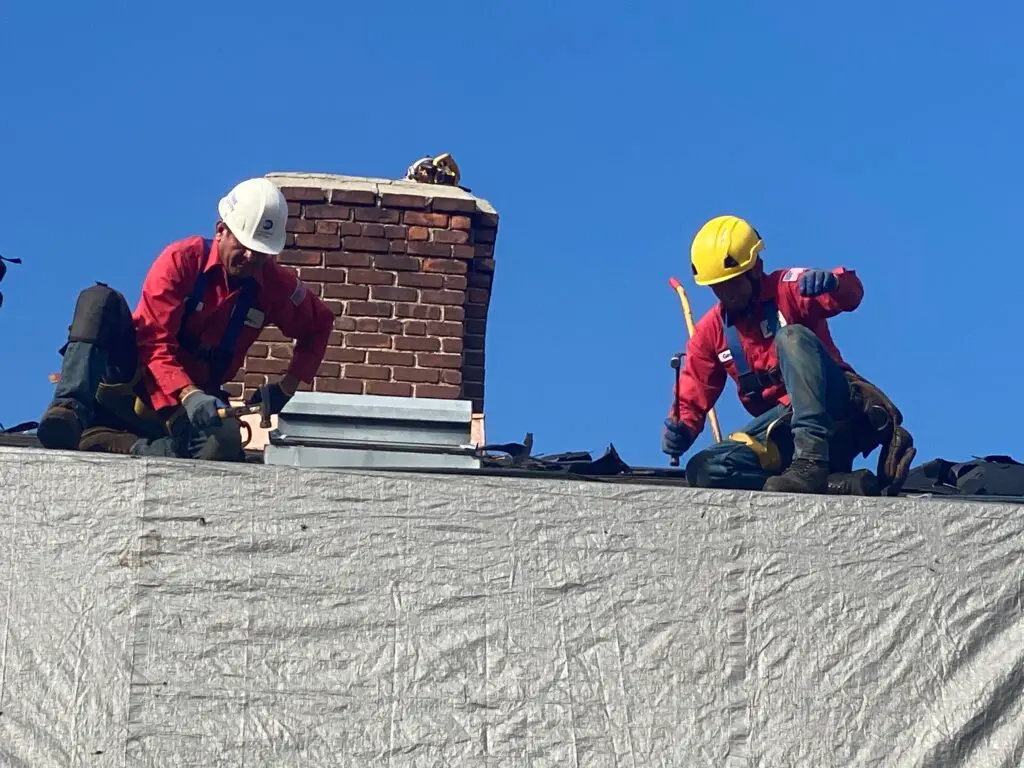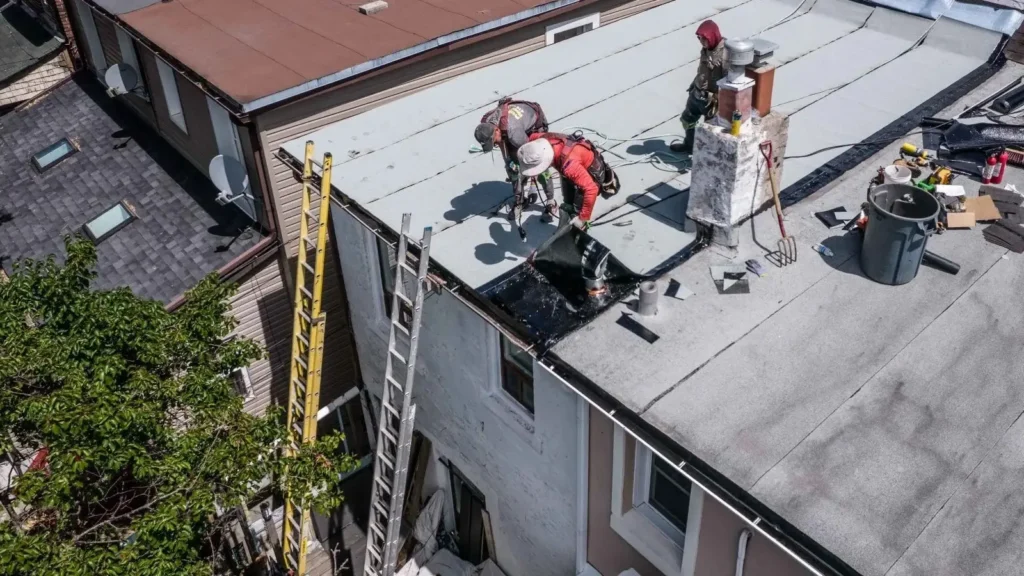
UPDATED FOR 2025
DIY Roof Repairs: The True Cost of Do-It-Yourself Repairs
Learn about the hidden costs of DIY roof repairs, including safety risks, voided warranties, and why homeowner repairs often cost more.
Key Takeaways:
- Many homeowners attempt DIY roof repairs in pursuit of cost savings, but this often backfires by voiding manufacturer warranties worth thousands of dollars and creating liability if improper work causes future damage or injury.
- Fall injuries from residential roofs result in 150-200 deaths and 15,000+ emergency room visits annually, with treatment costs averaging $50,000-$200,000.
- Homeowner’s insurance companies may deny coverage for damage caused by homeowner repairs, leaving you paying out-of-pocket for problems professional service would have covered.
- Improper DIY repairs typically cost 2-4x more to fix than the original professional repair would have cost, once you factor in materials waste, additional damage, and professional correction.
That YouTube tutorial makes roof repair look straightforward—just grab some shingles, a hammer, and a sunny afternoon, right?
Long Island homeowners increasingly attempt DIY roof repairs to save money, but most discover too late that roofing requires specialized knowledge, proper equipment, and techniques that videos can’t fully convey.
What starts as a $500 savings often becomes a $3,000-$8,000 disaster when improper repairs cause additional damage, void warranties, create safety hazards, or fail during the next storm.
Understanding the real costs of DIY roofing—both immediate and long-term—helps you make smarter decisions about protecting your home and your safety.

When DIY Actually Costs More
Professional roof repairs in Long Island typically cost $300-$1,500 depending on complexity and materials.
Many homeowners consider DIY roof repairs for the potential cost savings, hoping to avoid labor costs and better control their budget. However, the reality is that these savings are often not realized.
DIY repairs seem free beyond materials, but hidden costs add up quickly. Factor in equipment rental ($100-$300), materials waste from inexperience (20-40% more than needed), time value (8-16 hours for a job that professionals complete in 2-4), and risk of injury or additional damage.
When DIY repairs fail or cause additional problems—which happens in 60-70% of cases according to roofing contractors—you’ll pay professionals to fix both the original problem and damage your repair attempt caused. This typically costs 2-4x the original professional repair price.
The financial equation rarely favors DIY once you account for all costs. Professional repairs include warranties, proper materials, code compliance, and insurance protection that DIY can’t provide. While DIY is often seen as a way to save thousands, hidden costs usually erase those savings.

The Warranty Problem: Voiding Thousands in Coverage
Most Long Island homeowners don’t realize that manufacturer warranties require professional installation and repairs.
Your roofing materials likely came with 20-50 year warranties covering defects and premature failure. These warranties explicitly state that non-professional repairs void coverage entirely—not just for the area you repaired, but potentially for your entire roof.
Manufacturer Warranty Requirements
Shingle manufacturers require certified contractors to perform all work. Their warranties specify proper installation techniques, compatible materials, and documentation that homeowners can’t provide.
If your DIY repair causes problems later, the manufacturer denies warranty claims even if the underlying issue was material defect. You’ve eliminated your financial protection by attempting to save a few hundred dollars. Only a professional roofer can ensure your installation or repair meets all manufacturer warranty requirements and keeps your coverage intact.
Workmanship Warranties Disappear
Professional roofing companies like County Roofing Systems provide workmanship warranties covering installation quality for 5-10+ years. These warranties protect you if techniques or materials fail prematurely.
DIY repairs eliminate this protection entirely. When your repair fails, you’re paying full price to fix it—no warranty coverage, no recourse, no protection. That “free” repair just became very expensive.
Insurance Implications
Homeowner’s insurance providers cover sudden, unexpected damage from storms or accidents. It doesn’t cover damage resulting from improper repairs or maintenance.
Insurance adjusters investigate claim causes thoroughly. If they determine that homeowner repairs contributed to or caused damage, they deny claims. You’re left paying thousands out-of-pocket for problems insurance would have covered if professionals had done the original work.
Safety Risks: The Cost You Can’t Afford
Roofing ranks among America’s most dangerous jobs for good reason.
Falls from residential roofs cause 150-200 deaths annually and send 15,000+ people to emergency rooms with serious injuries. Most victims are homeowners attempting DIY repairs, not professional roofers with safety training and equipment. Even when working on your own house, the dangers are just as real as any commercial job.
Fall Injury Statistics
The average residential roof sits 15-25 feet above ground. Falls from this height commonly cause broken bones, spinal injuries, traumatic brain injuries, and death.
Emergency treatment for serious fall injuries costs $50,000-$200,000 depending on severity. Long-term care, rehabilitation, and lost work time add hundreds of thousands more. No DIY repair savings justify these risks.
Unsafe Working Conditions
Professional roofers use proper fall protection—harnesses, anchors, and safety lines that meet OSHA standards. They know how to navigate roofs safely, recognize hazards, and work in various weather conditions.
Homeowners typically lack safety equipment, training, and awareness of dangers. Algae-covered shingles, morning dew, and loose materials create slip hazards that experienced roofers recognize and avoid but homeowners discover through injury.
Weather and Physical Demands
Roofing requires working in direct sun, often in 90°+ temperatures on Long Island summers. Heat exhaustion and dehydration cause disorientation that leads to falls and mistakes.
Roofing is intense physical labor, which many homeowners underestimate. The physical demands—climbing ladders repeatedly, carrying materials, working on pitched surfaces—exceed most homeowners’ capabilities. Fatigue increases accident risks and error rates exponentially.
Liability Concerns
If you’re injured on your roof, your health insurance and disability coverage apply—but you’ve chosen to take these risks. If friends or family members helping you get injured, you may face liability lawsuits that homeowners insurance might not cover since they were performing construction work.
Code Violations and Legal Issues
Long Island building codes exist to ensure structural safety and weather protection.
Professional roofers know local codes and obtain necessary permits for repairs exceeding minor maintenance. They understand flashing requirements, material specifications, and installation standards that prevent failures.
Permit Requirements
Many Long Island jurisdictions require permits for roofing work beyond minor repairs. Homeowners typically skip permits, creating legal and financial problems.
Unpermitted work can prevent home sales—buyers’ attorneys and inspectors discover it during due diligence. You’ll need to obtain after-the-fact permits, potentially remove and redo work to meet code, and pay fines before closing. These costs can reach $5,000-$15,000 and delay or kill your sale.
Inspection Failures
When you eventually sell, home inspectors examine your roof carefully. They recognize improper repairs—wrong materials, incorrect installation, code violations—and document them in inspection reports.
Buyers use these findings as negotiation leverage, demanding credits equal to professional repair costs. You’ve saved nothing through DIY and actually cost yourself more by reducing your home’s sale value.
Insurance and Appraisal Issues
Insurance companies inspect roofs before writing policies. They refuse coverage or charge premium surcharges for roofs showing improper repairs or code violations.
Appraisers note code violations and improper work, potentially reducing your home’s appraised value. This affects refinancing and selling by limiting buyer financing options.

Technical Knowledge: Why Experience Matters
Roofing involves far more complexity than most homeowners realize. While DIYers may appreciate the complete control they have over their project—choosing materials, managing the budget, and setting their own schedule—there’s no substitute for the expertise and peace of mind that comes with hiring an experienced team.
What looks like simple shingle replacement actually requires understanding water flow patterns, proper sealing techniques, flashing integration, and how different materials interact. Small mistakes cause major problems.
Diagnosing the Real Problem
Water stains inside your home rarely appear directly below the actual leak. Water travels along rafters and through insulation before becoming visible.
Homeowners typically repair where they see damage, missing the actual source. The leak continues, causing additional damage while you’ve wasted time and money on ineffective repairs. An experienced team can quickly identify hidden issues that a DIYer might overlook, ensuring the real problem is addressed from the start.
County Roofing Systems’ 35+ years of experience means we find actual leak sources quickly, addressing root causes rather than symptoms.
Material Compatibility
Not all roofing materials work together. Certain adhesives don’t bond properly with specific shingle types. Some flashing materials corrode when touching certain metals.
Using incompatible materials—even quality products—causes premature failures. The materials themselves may be excellent, but improper combinations fail quickly and void warranties.
Installation Techniques
Shingle installation requires specific nail placement, proper sealing, correct overlap patterns, and appropriate fastener types. Each manufacturer has detailed specifications that affect warranty validity and performance.
Improper nailing—too high, too low, wrong angle, insufficient penetration—causes shingles to blow off in moderate winds. Incorrect sealing allows water infiltration. These aren’t obvious problems until failure occurs during the next storm.
Flashing Complexity
Flashing around chimneys, skylights, and valleys represents roofing’s most technical work. Proper flashing requires understanding water flow dynamics, correct material selection, precise cutting, and meticulous sealing.
Most DIY roof failures occur at flashing because homeowners lack knowledge to install it correctly. Professional roofers learn flashing techniques through years of training—it’s not something YouTube adequately teaches.
THE BEST WARRANTIES IN THE INDUSTRY- ONLY 2% OF ROOFING COMPANIES CAN OFFER
25-Year Labor, 50-Year Material Warranty
We’ve met the toughest requirements in the residential roofing industry- and we use only the best materials.
That’s why we stand behind our work with the best warranties in the industry- warranties only 2% of the roofing industry can offer.
Your house deserves the best roofing warranty on the market. Give us a call today and get a brand new roof with a 25-year labor, 50-year material warranty from the best roofing contractor throughout Long Island and New York.
Equipment and Material Costs Add Up
Professional-quality roofing requires specialized tools and materials that homeowners typically don’t own. Before starting any roof repair, it’s crucial to gather all the materials and tools you’ll need to ensure a smooth and effective process.
By the time you rent or purchase necessary equipment and buy materials (with inevitable waste from inexperience), your “savings” evaporate quickly.
Tool and Equipment Requirements
Proper roofing requires air compressors or pneumatic nailers ($200-$800), roofing hammers and specialized hand tools ($100-$300), hammer tacker, roofing shovel, roof jacks, safety harnesses and fall protection ($200-$500), quality ladders rated for roof access ($150-$400), and material lifts or scaffolding for multi-story homes ($300-$600 rental).
These costs total $950-$2,600 before buying materials. Professional roofers already own this equipment and spread costs across hundreds of jobs.
Material Waste and Errors
Inexperienced workers waste 20-40% more materials than professionals through cutting errors, damage during installation, and purchasing incorrect quantities or specifications.
Shingles come in bundles—you can’t buy exact amounts. Homeowners typically overbuy to ensure adequate supply, then can’t return opened bundles. That “cheap” repair becomes expensive when half your materials sit unused.
Wrong materials mean additional trips and costs. Choosing incorrect shingle types, wrong adhesives, or incompatible flashing wastes money and time while your roof remains vulnerable.
Time Investment
Your time has value. Repairs that take professionals 2-4 hours require 8-16 hours for homeowners—research, shopping, multiple attempts, and cleanup.
If you value your time at even $50/hour (less than professional rates), an 8-hour repair costs $400 in time value. Add material waste and equipment rental, and you’re approaching or exceeding professional repair costs before addressing quality or warranty concerns.
When DIY Repairs Cause Additional Damage
The most expensive DIY mistakes occur when attempted repairs cause new problems.
Walking on roofs damages shingles, improper repairs create new leak pathways, and using wrong materials causes accelerated deterioration. Failing to replace damaged components, such as old shingles or underlayment, can lead to further issues. You’ve transformed a contained problem into widespread damage.
Collateral Damage from Amateur Work
Walking on roofs requires knowing where to step. Homeowners commonly crack or dislodge shingles surrounding repair areas, creating multiple new leak points.
Before making repairs, it’s crucial to properly remove old shingles and old materials to ensure a solid foundation for new work. Prying up shingles incorrectly breaks seal strips and damages surrounding materials. Over-nailing cracks shingles. Under-nailing allows wind uplift. Failing to keep shingle rows straight during installation can also cause future problems with leaks and appearance. These mistakes multiply repair needs exponentially.
Water Damage Escalation
Improperly sealed repairs actually channel water into new areas. Poor flashing installation directs water behind walls. Incorrect shingle overlap creates pathways for wind-driven rain.
Water damage worsens with each rain event. By the time you realize your repair failed, significant interior damage, insulation destruction, and potential mold growth require expensive remediation—far exceeding original repair costs.

Structural Concerns
Homeowners walking on roofs sometimes step through damaged decking or break rafters stressed by hidden rot. Discovering major structural problems while standing on a roof creates dangerous situations and expensive repairs.
Professional roofers recognize structural red flags before stepping on compromised areas. Their experience prevents accidents and additional damage that DIY attempts cause.
Material Deterioration
Using wrong adhesives, incorrect nails, or incompatible materials accelerates deterioration in repair areas. Within months, the area shows premature aging and failure.
It’s important to remove old underlayment before installing new materials to ensure the integrity of the roof. You’ll need professional repairs anyway, but now you’re also paying to remove improper materials and fix damage your attempt caused. The total cost exceeds 2-4x what proper professional repair would have cost initially.
Replacing your roof is a complex process that requires careful planning, proper removal of old materials, and attention to detail to avoid costly mistakes.
DIY Roofing Mistakes to Avoid
DIY roofing projects can be rewarding, but they’re also full of potential pitfalls that can lead to expensive repairs if you’re not careful.
One of the most common mistakes is improper installation of underlayment, which can allow water infiltration and damage the roof deck.
Another frequent error is using too few roofing nails or placing them incorrectly, which can cause shingles to loosen and reduce your roof’s wind resistance.
Neglecting to install a drip edge or flashing properly is another costly oversight, as these components are critical for directing water away from vulnerable areas.
To avoid these mistakes, always follow manufacturer instructions, use the right materials, and take safety precautions—such as wearing a safety harness and using a roofing nail gun to ensure nails are driven correctly.
Regular inspections during and after installation can help catch issues early. If you’re unsure about any step of the process, don’t hesitate to consult a professional roofing contractor.
County Roofing’s expertise can help you avoid common errors and ensure your roof is installed safely and effectively.
Fill out the form below or give us a call today at (888) 366-6619:
The Professional Advantage: What You’re Really Buying
Professional roofing services provide value beyond just completing repairs. Consulting a reputable roofing company brings both expertise and peace of mind, ensuring your project is handled safely and correctly.
Understanding what professionals offer helps you appreciate why DIY rarely saves money once all factors are considered.
Experience and Expertise
County Roofing Systems’ 35+ years serving Long Island means we’ve encountered every roofing problem imaginable. We diagnose issues accurately, understand weather-specific challenges, and implement solutions that last.
This experience prevents the trial-and-error approach that characterizes DIY repairs. We get it right the first time, saving you time, money, and frustration.
Proper Materials and Suppliers
Professional roofers maintain relationships with quality suppliers and access contractor-grade materials unavailable to homeowners. We know which products perform best in Long Island’s climate and which to avoid.
Our bulk purchasing power means material costs actually favor professional repairs—we pay less for better materials than homeowners pay retail for inferior products.
Warranty Protection
Every County Roofing Systems repair includes workmanship warranties protecting you against installation failures. If anything goes wrong with our work, we return and make it right at no additional cost.
This protection has significant financial value that DIY can’t provide. Peace of mind knowing your repair is guaranteed matters when protecting your home investment.
Insurance and Licensing
Professional roofers carry comprehensive liability insurance and workers’ compensation coverage. If accidents occur or damage happens during work, insurance handles it.
DIY work leaves you personally liable for injuries to helpers and damage to your property or neighbors’ homes. This financial exposure alone justifies professional service.
Code Compliance and Permits
We handle permits, ensure code compliance, and provide documentation for future sales or insurance claims. This administrative work has real value in preventing future legal and financial complications.
Time and Convenience
Professional repairs complete in hours with minimal disruption. We handle cleanup, disposal, and weather protection. You can continue with your life instead of spending weekends on your roof.
When DIY Makes Sense (Rarely)
A few limited roofing tasks suit homeowner efforts—with important caveats. Working on your own roof may seem appealing, but it comes with significant risks.
Understanding appropriate DIY limits prevents costly mistakes while allowing legitimate homeowner maintenance.
Appropriate DIY Tasks
Cleaning gutters and removing debris represents reasonable homeowner maintenance. This prevents drainage problems without requiring technical roofing knowledge.
Inspecting your roof from the ground using binoculars helps identify obvious problems early. You can spot missing shingles or damage without roof access risks.
Trimming overhanging branches improves roof longevity but requires proper safety equipment and tree-trimming knowledge. Hire professionals for significant work.
The size and condition of your house can greatly influence whether a DIY job is feasible. Larger or older houses may present additional challenges that make the job more complex and risky for homeowners.
What to Absolutely Avoid
Never attempt repairs involving flashing, valleys, or penetrations—these are jobs that are best left to professionals. Never walk on roofs if you lack safety equipment and training. Never perform repairs during wet, windy, or icy conditions.
Don’t attempt repairs on steep-pitched roofs or multi-story homes. Don’t use cheap materials or incorrect products. Don’t skip permits when required.
When to Call Professionals Immediately
Active leaks require professional diagnosis and repair—water damage worsens rapidly. Missing shingles after storms need prompt professional attention before more damage occurs.
Any structural concerns—sagging, soft spots, or visible damage—demand professional evaluation immediately. These indicate serious problems that DIY approaches can’t address safely or effectively.

Real Cost Comparison: DIY vs. Professional
Let’s examine actual costs for a common repair—replacing damaged shingles around a roof penetration. The cost per square foot can vary significantly depending on the type of roof and materials used, such as asphalt roofs, metal roofs, or other options.
Professional Repair Costs:
Service call and diagnosis: $0 (free with repair)
Labor for repair (2-3 hours): $400
Materials (shingles, flashing, sealant): $150
Permits (if required): $75
5-year workmanship warranty: included
Total: $625
Asphalt shingle roofs are the most common for these types of repairs. Professional installation ensures proper techniques and materials are used, which is critical for the longevity and warranty of asphalt roofs.
If you’re considering a new roof, comparing the costs and benefits of asphalt roofs versus a metal roof is important—metal roofs often have a higher upfront cost per square foot but can offer greater durability and longer warranties.
DIY Attempt Costs:
Research time (4 hours @ $50/hr): $200
Equipment rental (ladder, safety gear): $150
Materials purchased retail: $200
Material waste (30%): $60
Labor time (8 hours @ $50/hr): $400
Total immediate costs: $1,010
DIY repairs on asphalt shingle roofs require specific materials, such as roof sealants designed for asphalt, and proper installation of new shingles. Mistakes with underlayment, flashing, or nail placement can compromise the effectiveness of the new shingles and lead to further issues.
Additional DIY Costs When Repair Fails:
Professional assessment: $150
Removal of improper work: $200
Repair of additional damage caused: $300
Correct repair of original problem: $625
Total professional fix after DIY: $1,275
Total DIY Cost: $2,285Total Professional Cost (done right initially): $625DIY “Savings”: -$1,660
While many homeowners hope to save money by installing a new roof or new shingles themselves, the risks of improper installation, voided warranties, and additional damage often outweigh the potential savings. This scenario assumes no injuries, no voided warranties, no insurance complications, and no major additional damage. Many DIY attempts cost far more.
Insurance Won’t Bail You Out
Understanding homeowner’s insurance coverage limits prevents costly surprises.
Homeowners often assume homeowner’s insurance covers everything, but DIY repairs create coverage gaps and claim denials.
What Homeowner’s Insurance Covers
Homeowner’s insurance covers sudden, unexpected damage from storms, accidents, or events beyond your control. It doesn’t cover maintenance, wear and tear, or damage from improper repairs.
DIY Exclusions
If homeowner’s insurance adjusters determine that homeowner repairs caused or contributed to damage, they deny claims. This includes situations where improper repairs allowed minor problems to become major damage.
Documentation matters. Homeowner’s insurance companies investigate thoroughly, examining repair areas and surrounding damage to determine causation.
Professional Repairs Strengthen Claims
Proper professional repairs with documentation support homeowner’s insurance claims when legitimate storm damage occurs. Contractors provide detailed assessments distinguishing new damage from existing conditions.
This documentation helps ensure fair claim settlements and prevents unjust denials.
Finding the Right Roofing Contractor
While a DIY roof replacement might seem like a way to save money, there are times when hiring a professional roofing contractor is the smartest investment.
When searching for the right roofing contractor, look for a company with a strong reputation, proven experience, and all necessary licenses and insurance. Check customer reviews and ask for references to ensure you’re working with a trustworthy team.
A reputable roofing contractor will provide a detailed estimate that breaks down materials cost, labor costs, and any additional expenses, so you know exactly what to expect. They’ll also ensure your project complies with local building codes and is completed safely and efficiently.
Choosing the right roofing contractor means you’ll benefit from expert installation, high-quality materials, and strong warranties—giving you peace of mind that your roof replacement or repair will stand the test of time.
Take the time to research your options and ask questions, so you can feel confident in your decision and protect your home for years to come.
The Smart Choice: Leave Roofing to Professionals
DIY roof repairs rarely save money once you account for hidden costs—voided warranties, safety risks, equipment expenses, time investment, and high failure rates.
Professional roofing services provide value beyond just completing repairs. You’re buying expertise, proper materials, code compliance, insurance protection, warranties, and peace of mind that your roof is actually fixed correctly.
County Roofing Systems has protected Long Island homes for over 35 years. We’ve repaired countless DIY attempts that cost homeowners far more than proper professional service would have cost initially. Our honest assessments help you understand what your roof needs and what repairs actually cost—no pressure, just straightforward information.
Protecting your home and family deserves professional expertise. Your roof isn’t the place to experiment with cost-cutting measures that usually cost more in the long run.
Don’t risk your safety or your home’s protection. Call County Roofing Systems at (888) 366-6619 for a free inspection and honest assessment. Let’s discuss the right way to address your roofing needs—safely, effectively, and affordably.
- First Approvals
- 0% financing
- No income check
- Up to 15 years
- Monthly payments as low as $149
Call today or contact us below for a FREE roofing estimate:
Frequently Asked Questions
Can I just watch YouTube videos to learn roofing?
Videos provide overview information but can’t convey the tactile skills, judgment, and experience that proper roofing requires. They also can’t teach you to recognize problems or adapt techniques to specific situations. Professional roofers train for years—no video series replaces this education.
What if I have construction experience in other areas?
Roofing involves unique challenges different from other construction trades. Even experienced contractors hire roofing specialists because the work requires specialized knowledge. Your carpentry or electrical skills don’t translate to roofing safety or techniques.
How does roof pitch affect DIY roof repairs?
Roof pitch, or the steepness of your roof, greatly impacts the difficulty and safety of repairs. Steeper roofs are much harder and more dangerous to work on, increasing the risk of falls and making it challenging to handle materials and tools. Professional roofers have the training and equipment to safely work on high-pitch roofs.
Why is installing a water shield important in vulnerable areas?
A water shield, such as an ice and water shield, is a protective layer installed in vulnerable areas like valleys, around chimneys, and along eaves. It helps prevent leaks caused by ice dams and wind-driven rain, protecting your home from water damage in spots most prone to moisture intrusion.
What is the role of a ridge vent in roof ventilation?
A ridge vent is installed along the peak of the roof to allow warm, moist air to escape from the attic. Proper installation of a ridge vent is essential for maintaining airflow, reducing moisture buildup, and extending the life of your roofing system.
Don’t professionals charge too much for simple repairs?
Professional pricing reflects expertise, proper materials, insurance, warranties, equipment costs, and business overhead. When you factor in DIY hidden costs—equipment, time, risk, lack of warranty, and high failure rates—professional service represents better value.
Can’t I just hire someone cheap to help me?
Unlicensed “helpers” provide no warranties, carry no insurance, and often lack proper knowledge. You’re still liable for their mistakes and injuries. Cheap help usually means paying twice—once for their failed attempt, again for professional correction.
What about emergency temporary repairs until professionals arrive?
Unlicensed “helpers” provide no warranties, carry no insurance, and often lack proper knowledge. You’re still liable for their mistakes and injuries. Cheap help usually means paying twice—once for their failed attempt, again for professional correction.
What about emergency temporary repairs until professionals arrive?
For active leaks during storms, placing tarps or buckets is reasonable emergency response. Don’t attempt permanent repairs. Call professionals immediately so they can assess damage and implement proper solutions before conditions worsen.

